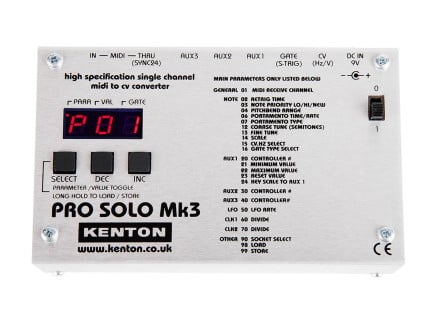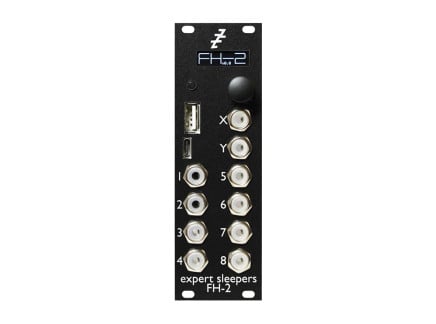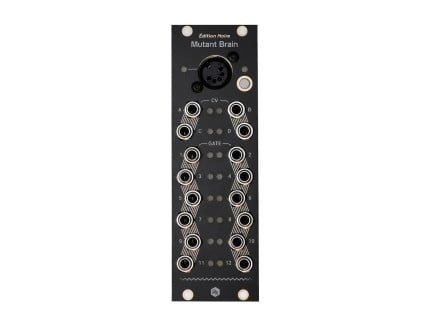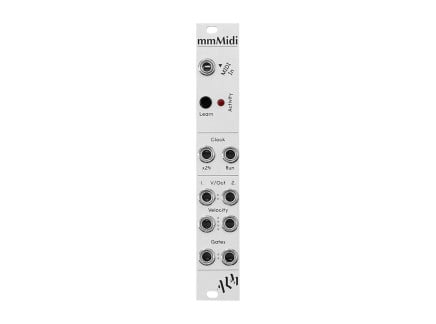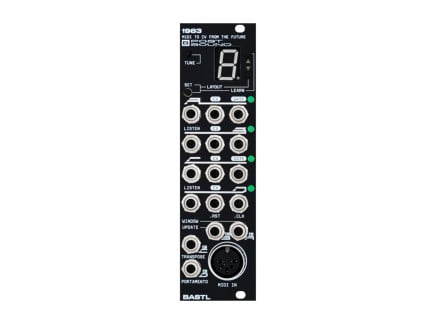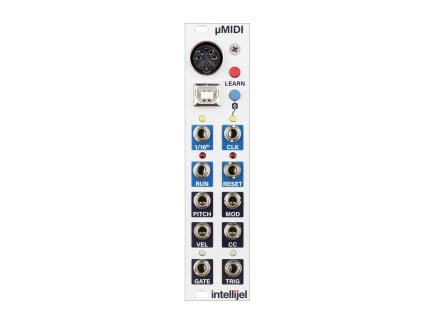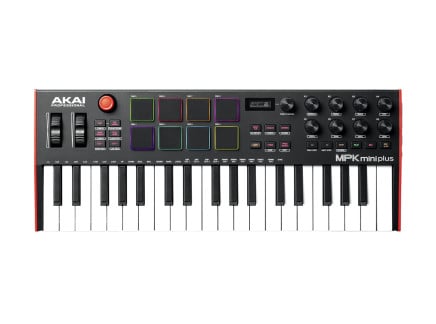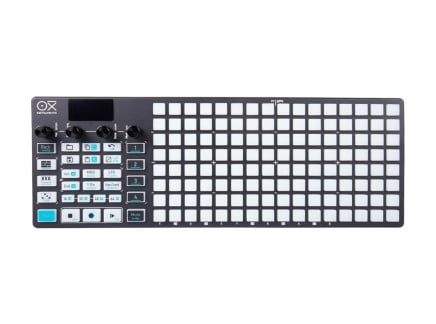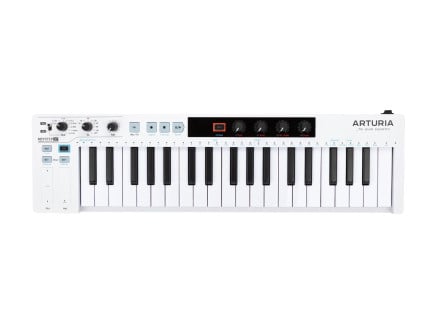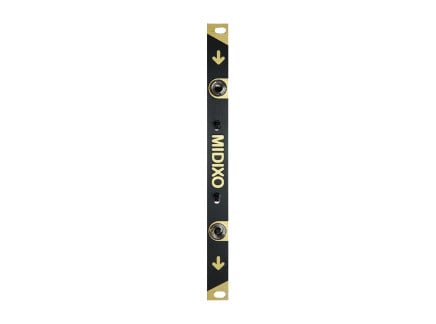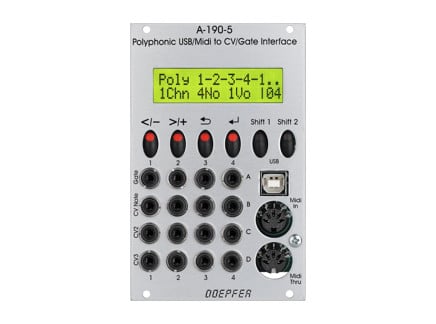For many years, the dominant control method for synthesizers was the paradigm of CV (control voltage) and gate (on/off messages), an analog standard that directly translates analog voltages to control parameters within a synthesizer. The specifications of the control scheme of analog synthesizers varied between many manufacturers, such as in Moog's 1V/oct, Korg's Hz/V, or Buchla's 1.2V/oct pitch scaling schemes, as well as in their differing voltage range and gate/pulse formats. With the advent of digital synthesizers and more specifically polyphonic digital synthesizers, manufacturers sought to overcome the inherent incompatibilities between their products by developing a universally compatible communication standard for new instruments. Out of this need arose a new digital communication standard: MIDI, or Musical Instrument Digital Interface. For a deeper dive into the history of MIDI, please see our article, A Brief History of MIDI.
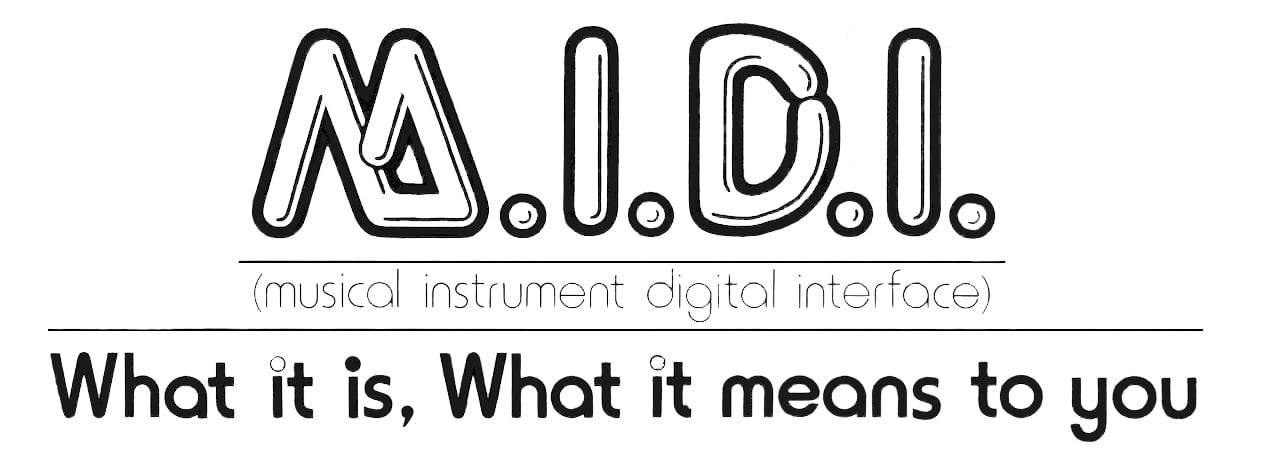
We're going to assume you have some knowledge of MIDI, but let's briefly summarize how it works. MIDI is a protocol that allows instruments to send data to/from one another or to/from a computer. This data typically includes information pertaining to note start/stop (on/off), pitch, and velocity (volume)—but it may also include other information, such as pitch bend, or the BPM of the source instrument or project. Typically, MIDI messages are fairly low-resolution, featuring a range of integer-only values from 0–127. The pitch range of MIDI goes from C-1 (0) to G9 (127), with middle C, also known as C4, placed at the note value 60. Additional information may be sent over continuous controller/control change (CC) messages, which may send a range of values from 0–127 to preset or assignable destinations (commonly used to control aspects of sound other than basic pitch or timing information).
One of MIDI's great advantages is that it allows transmission of a large amount of simultaneous control data over a single cable. Compared to the one-cable-per-parameter approach of modular synthesizers and early analog keyboard synths, this offers a significant reduction of clutter, and makes it much simpler to create complex, recallable control structures between multiple instruments.
While this has distinct advantages over standard CV/Gate-based approaches, though, modular synthesizers weren't made obsolete by MIDI: and today, it is relatively common for studios and performance setups to employ a combination of MIDI and CV-capable gear. The trick, then, is about how to get these different types of gear talking with one another—and one of the most common approaches involves translating MIDI data into CV. And that's where we get to the main topic of this article: What is a MIDI to CV Converter, and how does it work?
What is a MIDI to CV Converter?
MIDI to CV converters take MIDI messages and convert them into voltages a modular synthesizer understands. MIDI to CV converters cover a wide range of features, and different converters may work better or worse for different applications. Some of the simplest options convert MIDI note information to a pair of Pitch CV and gate outputs, great for using a MIDI keyboard or sequencer to provide straightforward pitch and timing information to an analog synth voice. Others are better-suited for sending many CC messages as CV signals. Some occupy a small form factor for when space is limited, while others work as a drum machine sequencer with many gates or trigger outputs for initializing envelopes, drum modules, or samples.
Knowing a bit more about what is possible, let's take a look at a few different forms that a MIDI to CV converter can take, discussing the pros & cons of each approach and offering some modern real-world examples of each as we go. Specifically, we'll discuss: Standalone MIDI to CV converters, Eurorack-format MIDI to CV converters, and using MIDI controllers as MIDI to CV devices. Let's take a look at each approach, discussing its advantages and disadvantages while looking at specific examples of modern devices along the way.
Standalone MIDI to CV Converters
One of the simplest and longest-standing approaches to MIDI–CV conversion involves using a standalone MIDI to CV solution: a self-contained device that accepts MIDI at its input, and produces any number of outputs which—depending on the device's own intended use—may include scaled pitch CV signals, gates, outputs which produce voltages in response to MIDI CCs, clock outputs, and more.
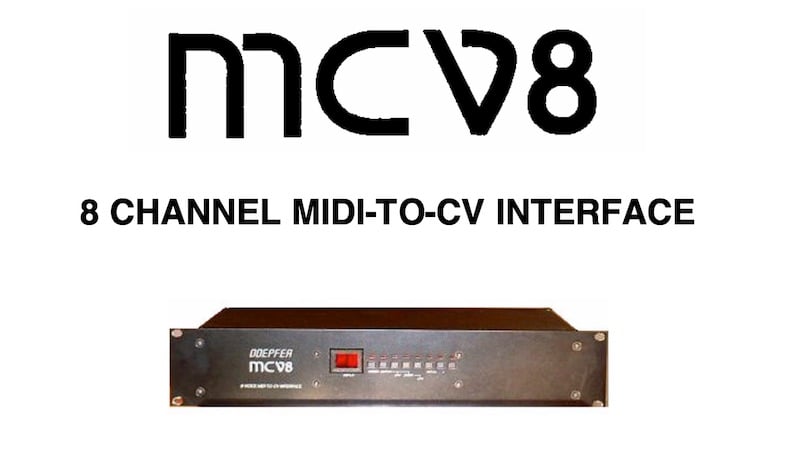
These types of devices have been around since shortly after MIDI's original inception, offering a solution that allowed modular synthesizer owners to take advantage of the new and nearly universal MIDI technology in the early 1980s. One of the earliest such devices was the Doepfer MCV8 (shown above), produced from the mid-1980s to early 1990s. It was available in several versions, ultimately settling on a rackmount format with sixteen 1/4" outputs in order to produce eight pitch CV signals and eight gates—great for adding MIDI-controlled polyphony to a modular synthesizer system. Another interesting early example of such a device was Roland's MPU-101—a surprisingly advanced device for its time. It features four output channels, each with CV, gate, and dynamic outputs. It also featured individual outputs for pitch bend, modulation, volume, and aftertouch...features still not found on many such modern devices. It was capable of monophonic and polyphonic operation, and provided user control of voice allocation for a number of peculiar polyphonic tricks.
Not surprisingly, devices like these are still available today from companies like Doepfer and Kenton Electronics. A standalone MIDI to CV solution may be particularly convenient for users with self-contained CV-capable instruments, such as standalone semi-modular synthesizers, keyboards, or vintage semi-modular or keyboard synths. Given the enormous number of CV-capable semi-modular and keyboard synth over the last several years, we trust that a standalone solution will be attractive ot many. And of course, a standalone solution can still be used along with your fully modular synthesizer...but if you're working in the Eurorack format, you may find an in-rack solution more convenient. (We'll discuss that in just a bit.)
One of our long-standing favorite MIDI to CV solutions is the Kenton Pro Solo Mk3, which offers a number of CV outputs in a compact, affordable desktop package. Send a MIDI DIN connection in and you'll be able to get Pitch CV, Gate, and three auxiliary CV signals out. The Pitch CV output can operate in 1V/Oct or Hz/Volt standards, and the Gate output can produce V-Trig or S-Trig signals...making it a great choice for use with dang near every CV-capable instrument out there. The three Aux outputs can produce a wide range of user-selectable behaviors—note velocities, specific CCs, LFOs, envelopes, and more. Alternatively, you could look at the Kenton USB Solo, which provides similar functionality, but substitutes the DIN input for a USB connection for easy CV generation from a computer.
Doepfer's Dark Link offers similar functionality, with a single Gate output and four CV outputs—each pre-programmed to a fairly specific function. The CV outputs produce 1V/Oct Pitch CV (with front-panel glide control knob), a pitch bend voltage, a velocity voltage, and an assignable controller voltage. Overall, it's a bit less flexible than the Pro Solo...but if what you need is a straightforward way of controlling a monophonic synth voice, it's a solid and reliable choice. And, as a bonus, it also features USB input, making it a good choice with computer or hardware MIDI controllers.
Of course, there are more complex MIDI to CV solutions out there as well—one of our favorites is the Kenton Pro 2000, which expands on the Pro Solo's functionality considerably. It offers two dedicated Pitch CV and two dedicated Gate outputs, and a whopping six assignable Auxiliary outputs...again, allowing for everything from Velocity voltages, assignable LFOs, CC to CV conversion, and much more. If you need to take control of a large number of parameters or several individual synth voices, Pro 2000 is a solid choice.
Need more options? Check out our full selection of standalone MIDI to CV converters here.
Eurorack Format MIDI to CV Converters
Of course, if you're trying to add MIDI control to your modular system, an in-rack solution may be the most effective solution. There are many Eurorack modules designed specifically for the purpose of converting MIDI data into control voltages. Some have fairly straightforward intended uses, while others offer a much more open-ended approach to MIDI to CV conversion. Let's see how those approaches might look.
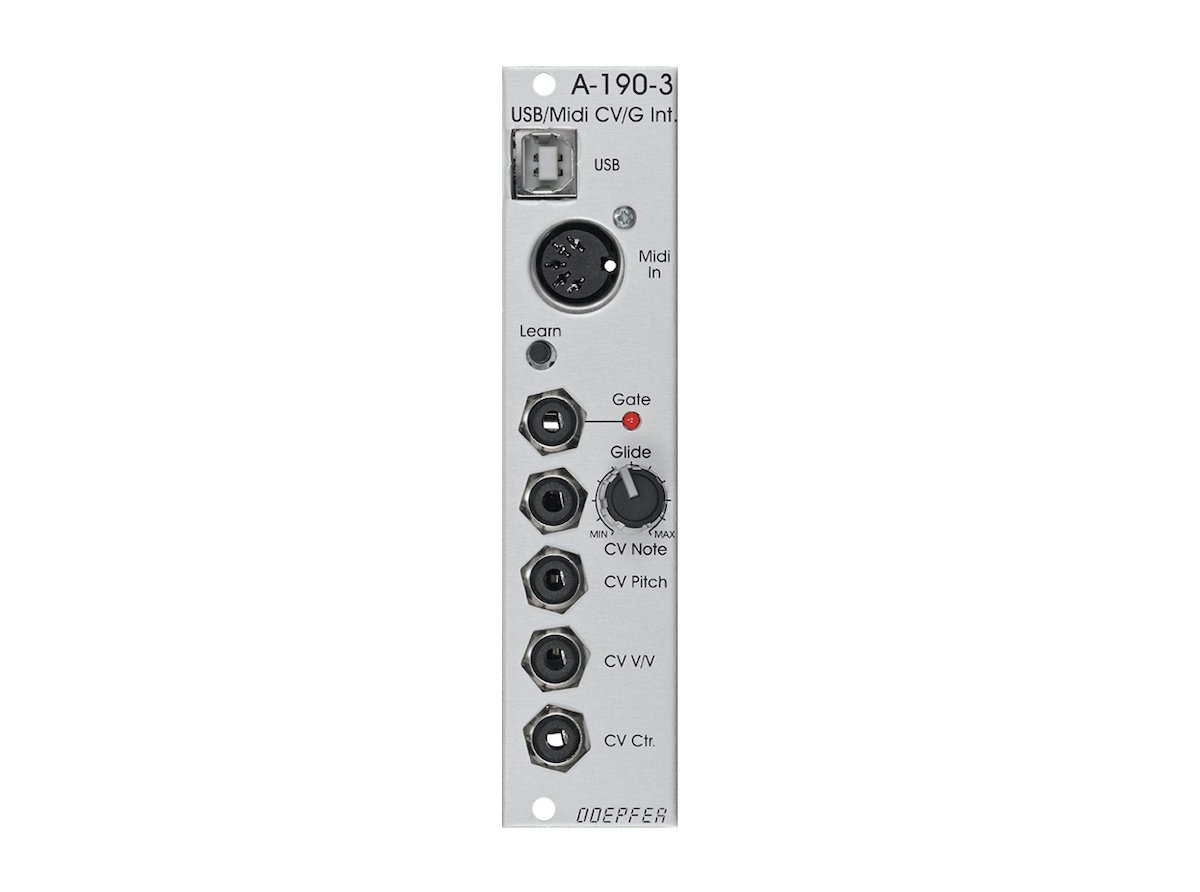
On the simpler end of the spectrum are options like, for instance, Doepfer's A-190-3—basically a Eurorack-format version of the aforementioned Dark Link. Its outputs are more or less hardwired to produce specific functions: there's a dedicated note gate output, 1V/octave pitch CV output, a pitch bend CV output, velocity CV output, and an assignable CC output. If you need a simple MIDI to CV solution for control over a single monophonic synth voice, then this module alone should do the trick. However, there are a lot of other reasons you might need to convert MIDI data to CV. For instance, what if you need to trigger eight drum sounds? What if you need to use a slider-based controller to send manual modulation signals to a lot of parameters in your patch? A more fully-featured MIDI to CV solution just might be the thing.
One of our favorite choices for in-the-rack MIDI-CV management is the FH-2 from Expert Sleepers, in large part due to its incredible flexibility. With its dual USB ports, FH-2 serves as an ideal mediator between a Eurorack system and any assortment of USB MIDI capable hardware, like USB controllers, grooveboxes, or computers. Beyond this, its eight outputs are entirely configurable through the module's user interface or a web browser when connected to a computer. Once set up, FH-2 can easily translate any type of MIDI data such as notes, CCs, and MIDI clock into immediately useful voltages to be patched out to other modules. There's also several handy functions built in, like ADSR envelopes, Euclidean pattern generators, sequencers, and a lot more to further generate and process incoming MIDI or CV signals.
Speaking of CV input, the X and Y inputs on the FH-2 are not only useful for modulating internal parameters, but may also be used for converting control voltages into MIDI data to send out to connected devices. This means you can use your modular system's LFOs, random voltage generators, and other CV sources as ways of modulating parameters on your MIDI-capable gear. If that wasn't enough, FH-2 can be expanded using the FHX-8CV and FHX-8GT expanders for adding extra CV and gate outputs, respectively...in fact, it can be expanded to produce up to 64 simultaneous gate or CV outputs(!!). Additionally, you can use FH-2 in conjunction with the Expert Sleepers MIDI Breakout or TMB (Tiny MIDI Breakout) to connect directly to gear with 5-pin DIN connections or 3.5mm connections.
Another similar option is the Shuttle Control by Endorphin.es, which, like the FH-2, is totally configurable in how it translates MIDI data into control voltages. As with the FH-2, Shuttle control primarily connects to other gear via USB, with a USB-B "to device" port for connecting to computers and two "to host" ports for connecting USB MIDI controllers.
Unlike FH-2, Shuttle Control has no control voltage inputs—but it does have a whopping 16 full-range CV outputs, making it well equipped to interpret multiple MIDI notes or even MPE data and spit it out as useful CV signals. Shuttle Control is fully configurable through a handy web interface tool, where you'll also find access to advanced features like LFOs, envelopes, arpeggiators, random and probabilistic operations, and more. It can even pull double-duty as a Eurorack power supply, making it a great choice for dense, portable rigs.
Some years ago, Hexinverter noted that many inexpensive MIDI controllers allowed for complex sequencing possibilities not easy to achieve in Eurorack alone. They realized that, by separating the sequencer from the rack, users could gain an immense amount of flexibility, using whatever MIDI source worked best for them. Growing out of thsi concept—and taking yet another approach to MIDI to CV conversion—Hexinverter's Mutant Brain acts as the central nervous system of a modular synthesizer. It offers a special focus on rhythmic sequencing thanks to its 12 assignable gate/trigger outputs. It also provides four CV outputs in addition to the gate/trigger outputs.
A web-based companion tool allows for easy configuration of all 16 outputs. The four CV outputs can correspond to MIDI notes, pitch bend, velocity, aftertouch, fixed voltage levels, or MIDI CC messages. The 12 gate outputs feature a range of behavior from gates, retriggers, transport messages (start, stop, run, reset), or divisions of the MIDI clock. Hexinverter's line of Mutant Drum modules took the topology of classic drum sounds and reinvented them to create altogether new drums. The Mutant Brain ties all of them together, providing extensive sequencing/clocking/triggering options for multi-voice, rhythm-oriented systems.
Bastl's 1983 is another MIDI to CV interface that packs many features up its sleeves. The four channels can function in a number of ways, ranging from four-voice polyphony (four CV and four gate) to eight channels of CC messages. One unique feature of the four-channel module is a dedicated "listen" input for each set of CV and gates. These 'listen' to simple waveforms (triangle, sawtooth, pulse, or sine), and based on the source oscillator's frequency, can adjust the MIDI tracking to keep everything in tune over its seven-octave range. It also supports microtuning, allowing users to nudge the semitones of a 12TET scale up or down minutely. Not only does it have CV outputs, but four CV inputs also allow for control over MIDI note allocation, note transposition, triggered note updates, and portamento to add slide between notes. In quantizer mode, these CV inputs act as the source inputs for the quantizer.
Integrating your MIDI and modular gear has never been easier. The plethora of converters that marry these two formats bring out the best parts of both. It's the marriage of (nearly) universal communication and free-form signal routing that make MIDI to CV converters a useful way to unify your studio. If you need more options, be sure to check out our full selection of Eurorack-format MIDI to CV converters.
MIDI to CV Conversion in Unexpected Places
We've saved one of our favorite approaches to MIDI to CV conversion for last: doing MIDI to CV conversion by using a specialized sort of MIDI controller. A few years ago, this wouldn't quite have been possible because, well, very few MIDI controllers offered dedicated CV outputs. Today, though, it's a fairly common feature. Let's look at some examples, discussing how this approach might work along the way.
Currently, one of the most popular keyboard controllers altogether is Arturia's Keystep, and for good reason: it offers a ton of unique features not found on any other controllers in its price range. For our current purposes, the most important of these features is its inclusion of three 3.5mm outputs designed specifically for use with modular synthesizers: a 1V/octave pitch CV output, gate output, and an assignable mod output (which could send CV based on the mod touch strip, aftertouch, etc.). The most obvious use case for these outputs is to use them to translate real-time playing into CV/Gate/Modulation signals, giving you immediate hands-on control of your modular synthesizer. Heck, you could use these in conjunction with the built-in arpeggiator and sequencer as well.
The even more interesting thing, though, hinges around the fact that Keystep also has MIDI input, either via 5-pin DIN or USB (from a computer). Interestingly, if you send MIDI notes to the Keystep from an external source, it will translate those notes into CV at the appropriate outputs. So, even without needing a dedicated MIDI to CV converter, you have the ability to do basic MIDI to CV conversion. In fact, the Keystep also has a 3.5mm "sync" output, which can be synchronized to incoming MIDI clock data, allowing you to easily sync up your modular sequencers and modulation sources to the tempo on other devices or your DAW. The Keystep 37 functions in much the same way, but adds more keys and some additional performance features (it's one of our favorite controllers, period).
Happily, the Keystep isn't the only thing out there that can do these types of tricks. The Keystep Pro, for instance, offers similar functionality with a load of additional outputs, great for use with multi-voice systems. The Akai MPK Mini Plus is another keyboard controller similar to Keystep, offering dedicated pitch, gate, and modulation CV outputs alongside 3.5mm clock inputs and outputs. Unlike the Keystep, the MPK Mini Plus also features real pitch and mod wheels, a joystick, and several assignable CC knobs, great if you're trying to get more fully-featured, hands-on MIDI control. The Keith McMillen QuNexus is yet another similar option, offering several CV outputs, a three-track arpeggiator/sequencer, and more.
One of our other favorite devices for pulling off this MIDI to CV conversion trick, though, isn't a keyboard controller at all—it's a sequencer. Korg's SQ-1 is yet another tremendously popular controller because, like the Keystep, it does so much for the price. It's a solid standalone CV sequencer, it can sequence MIDI gear, and—not least of all—it can, as we've been describing, convert MIDI data into CV for use in modular synthesizers. It has some additional strengths—namely, it can convert data on two MIDI channels simultaneously. So, if you're trying to control two distinct voices on your synthesizer at one time, it's up to the task. However, unlike the other options we've described so far, the SQ-1 only produces pitch CV and gates on each channel, so you don't have any additional outputs for CCs, velocity, aftertouch, or other performance data.
Of course, there are plenty of other options out there. Novation's SL series controllers all feature CV outputs, as do many fully-featured sequencers like the OXI One. Additionally, many synthesizers also offer dedicated CV outputs—for instance, the ASM Hydrasynth family all have pitch, gate, clock, and two assignable CV outputs. The assignable mod outputs interestingly are assigned via the internal modulation matrix, and the mod matrix allows use of external CCs or internal performance variables as modulation sources. That is to say, in addition to the pitch CV, gate, and clock outputs, you could send CCs to the Hydrasynth from your computer and convert them into control voltages; or you could use the Hydrasynth's own keyboard to send out velocity or aftertouch CV; or you could use the Hydrasynth's own LFOs or envelopes to send modulation signals out of the instrument. It's an amazing synthesizer and, happily, an amazing controller on top of that.
That said, buying a synthesizer probably isn't the easiest or more economical way to get MIDI to CV conversion going in your own setup. The takeaway here, though, is that we'd recommend taking a close look at the gear you already have on hand, or controllers you might have your eye on: it's possible that there's a MIDI to CV solution hiding in plain sight.
Some Extra Things You'll Want to Consider: Tuning & Resolution
We've talked about some things you'll want to consider when picking out a MIDI to CV converter already—for instance, you'll want to make sure that you have enough outputs for your purposes. You'll want to make sure that your MIDI to CV converter of choice can convert the type of MIDI data you need, be it notes, CCs, or triggers. But there's more to it than just this—so before we close out this article, we want to talk about some additional technical considerations. First off...we need to talk about tuning and resoultion.
The tuning of the destination oscillator is extremely important when tracking with MIDI. Generally speaking, you want to tune your oscillator to the lowest note in the sequence. Send a MIDI note of a C1 to your oscillator and then reference a tuner or hertz counter on an oscilloscope and match the oscillator's pitch to the incoming MIDI note. The standard concert pitch in the UK and US is A440, meaning that the A note above middle C (A4) is tuned to 440Hz. This is one way of tuning your oscillators, but by no means the perfect or only way to tune them. This type of fine-tuning is typically not required for parameters other than pitch—our ears are, of course, very sensitive to changes in pitch, but not as sensitive to changes in loudness, timbre, etc. So if you're using MIDI to control pitch of an analog device, expect to take a little bit of time tuning things up. Note, though, that the Bastl 1983 described above overcomes some of these issues using the "listen" inputs to automatically compensate for pitch deviation...so, there are workarounds for this tuning process on some devices!
Due to the fact that MIDI is a digital protocol with limited resolution, fast CC changes may incur some audible stair-stepping in the analog realm. CCs can only have 128 discrete values, so on parameters where we're particularly sensitive to changes (pitch, loudness, etc.), this stair-stepping can be very obvious and unpleasant. An easy way to eliminate this is with an external slew generator, which will smooth out the hard digital edges to ensure smooth voltage changes. Again, the success of this approach depends on the relationship between the slew rate and the rate of change of the CC value—so you may need to do some tweaking in order to get completely smooth parameter changes.
Extra Considerations: Connectivity
MIDI originally employed a 5-pin DIN connection, but two of the five pins, pins 1 and 3, were unused. DIN remained a popular standard for decades (and is still common on all sorts of electronic music gear), and eventually, with the development of USB, MIDI became a standard part of the USB specification. As such, USB has also become a fairly standard way of communicating MIDI between multiple devices (more thoughts on that below!).
DIN connectors are relatively large, and the unused pins mean a certain amount of wasted real estate...so in a world where electronics have grown more and more compact, DIN MIDI connections can be a bit clunky. Because of this, many manufacturers have begun to use 3.5mm TRS connections for MIDI. This three-conductor connection standard is commonly found on stereo headphone jacks and other audio equipment, so the parts are both readily available and occupy a small footprint. While the same size as Eurorack connections, note that TRS MIDI does not work if plugged directly into a 3.5mm CV/gate input. In order to convert MIDI information into something that your Eurorack modular or semi-modular device understands, you still need a dedicated MIDI to CV converter.
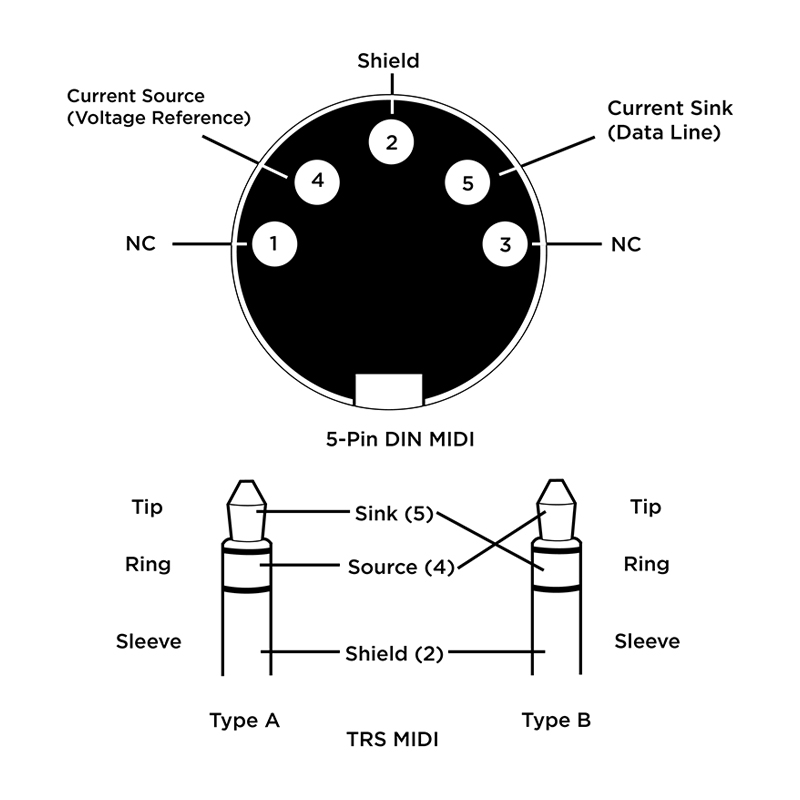
TRS MIDI comes in two distinct forms, Type A and Type B. Companies such as Korg and Make Noise use Type A, adopted as the MIDI standard in 2018. Although not the official standard, Type B still retains some popularity, including its use by Arturia and 1010 Music. Devices from all these manufacturers typically come with a dedicated TRS to 5-pin DIN adapter cables, allowing the device to connect to devices with the older standard 5-pin DIN MIDI jacks. Using a pair of TRS to DIN converters allows you to convert from A to B and vice versa.
The XOXO Modular MIDIXO takes the hassle out of MIDI TRS types, offering a simple solution to switch between the two standards. On top of that, it works with Expert Sleepers devices such as the FH-2 and Disting Mk4, adding TRS MIDI connections to them for general-purpose interfacing and uncovering some under-the-hood features. For more information on Expert Sleepers' MIDI offerings, see the recent Signal article on them: Which Expert Sleepers Interface is Right For You?.
Another consequence of the aforementioned adoption of MIDI as part of USB protocol was the development of USB MIDI controllers—in the present day, it has become common for MIDI controllers to offer any combination of DIN, TRS, and USB MIDI connections. In fact, many MIDI controllers intended to be used with computers now feature only USB connections. In order to use a MIDI to CV converter with such devices, a separate MIDI host is required, such as a computer or a device such as the USB MIDI Host from Kenton. For more info on USB Hosts, please see the article What is a MIDI USB Host?. Devices like the aforementioned Expert Sleepers FH-2, Endorphin.es Shuttle Control, and Squarp Hermod feature built-in USB hosting, allowing you to plug your external controller directly in and use it with no hassle. (Coincidentally, these are some of the most interesting and multi-functional MIDI to CV converters altogether.)
Because MIDI is a 40-year-old technological standard, some improvements and extensions have been made over the years. MPE, or MIDI Polyphonic Expression, expands polyphonic expression by allowing control over the parameters of individual voices instead of the global control common in most MIDI-capable instruments and controllers. This includes individual pitch bend and timbre per-note, allowing for improved dynamic and expressive playing when using a compatible controller and instrument. At the January 2020 NAMM show, a proposal for an official MIDI 2.0 protocol brought together many manufacturers as they worked to introduce a new interaction of this nearly universal standard. One of the most important features of MIDI 2.0 is backward compatibility, allowing new MIDI instruments and old ones to communicate seamlessly. While we have yet to see a MIDI 2.0 to CV converter, it is only a matter of time. MPE-compatible MIDI to CV converters are relatively common, however: again, the Endorphin.es Shuttle Control and Expert Sleepers FH-2 are some of our strongest recommendations.
Connecting the Dots
Of course, the number of ways you can interconnect gear is nearly limitless. We've outlined a handful of ways to connect your MIDI and CV-capable devices. You can get a standalone MIDI to CV converter; you can get a MIDI to CV Eurorack module; or alternatively, you can use a controller or instrument to handle MIDI to CV conversion—meaning that you might just have all the tools you need on hand right now.
But there are other weird and wonderful ways to make the worlds of MIDI and CV talk. If you want to know more, check out our guides on Connecting Your Computer + Modular Synths, as well as our detailed article about the weird world of CV to MIDI Conversion.

